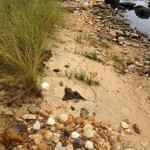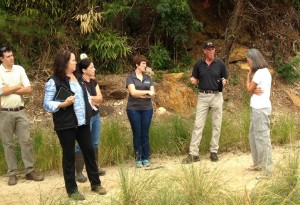Living Shorelines, Healthier Waters
 A recent study, funded by NOAA, found that the bay’s hardened shoreline (using rocks and walls to slow erosion) could be hindering estuary recovery following decades of pollution, as well as depriving fish, crabs and terrapins of habitat. Enter living shorelines, a concept that has existed for decades, but continues to evolve.
A recent study, funded by NOAA, found that the bay’s hardened shoreline (using rocks and walls to slow erosion) could be hindering estuary recovery following decades of pollution, as well as depriving fish, crabs and terrapins of habitat. Enter living shorelines, a concept that has existed for decades, but continues to evolve.
With progress top of mind, representatives from across DNR recently visited two living shoreline projects in Anne Arundel County, a Severn River project completed this summer and a 15-year old South River undertaking.
“It was fulfilling to tour a site designed in 2000 and one designed just last year and see that both are able to maintain the dynamic nature of the shoreline while simultaneously reducing erosion and maximizing wildlife habitat,” says Kevin Smith who leads aquatic restoration projects for DNR. “This is a challenging feat.”
In addition to these benefits, community members appreciate the enhanced public access of these projects while others are grateful that they also respond to environmental impacts like storm surge and sea level rise.
The purpose of the Anne Arundel County tour was to determine best practices for future projects that meet the needs of a wide gamut of DNR  perspectives: bay health, public access, community outreach, environmental regulations as well as wildlife and fish habitat.
perspectives: bay health, public access, community outreach, environmental regulations as well as wildlife and fish habitat.
“I’ve been involved with bay education for 25 years, and I still learned something on our recent tours,” says DNR Habitat Restoration and Conservation Section Chief Claudia Donegan. “I found it very interesting that living shorelines allow wrack to wash up, which provides not only nesting habitat for turtles and other animals, but also shelter for newborn animals before they are ready to enter the bay and face predators. I lifted up a pile of wrack today and found a baby water snake, demonstrating living shorelines in action and why these projects are so important to the environment.”
DNR’s Shoreline Conservation Service staff provides support to interested organizations, including site visits and evaluations, recommended solutions as well as financial and technical assistance.
